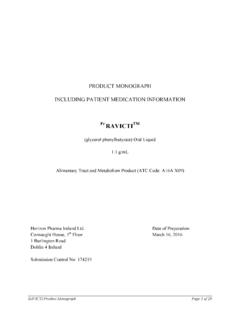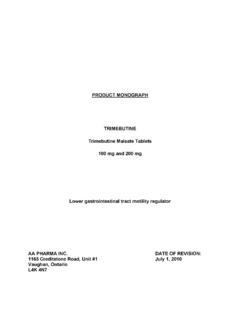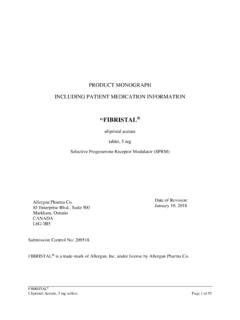Transcription of [Product Monograph Template - Schedule D]
1 TRESIBA (insulin degludec injection) - product Monograph Page 1 of 64 product Monograph INCLUDING PATIENT MEDICATION INFORMATION TRESIBA insulin degludec injection TRESIBA FlexTouch 100 U/mL, Solution for injection in a pre-filled pen TRESIBA FlexTouch 200 U/mL, Solution for injection in a pre-filled pen Antidiabetic Agent Ultra-Long-Acting Basal Insulin Analogue Novo Nordisk Canada Inc. 101-2476 Argentia Road Mississauga, Ontario Canada L5N 6M1 Date of Approval: July 17, 2018 Submission Control No: 208917 TRESIBA (insulin degludec injection) - product Monograph Page 2 of 64 Table of Contents PART I: HEALTH PROFESSIONAL INFORMATION .. 3 SUMMARY product INFORMATION .. 3 3 INDICATIONS AND CLINICAL USE .. 3 CONTRAINDICATIONS .. 4 WARNINGS AND PRECAUTIONS .. 4 ADVERSE REACTIONS .. 8 DRUG INTERACTIONS .. 16 DOSAGE AND ADMINISTRATION .. 17 OVERDOSAGE .. 20 ACTION AND CLINICAL PHARMACOLOGY.
2 20 STORAGE AND STABILITY .. 23 SPECIAL HANDLING INSTRUCTIONS .. 24 DOSAGE FORMS, COMPOSITION AND PACKAGING .. 24 PART II: SCIENTIFIC INFORMATION .. 25 PHARMACEUTICAL INFORMATION .. 25 CLINICAL TRIALS .. 26 DETAILED PHARMACOLOGY .. 37 TOXICOLOGY .. 39 REFERENCES .. 41 PART III: PATIENT MEDICATION INFORMATION .. 43 TRESIBA (insulin degludec injection) product Monograph Page 3 of 64 TRESIBA (insulin degludec injection) PART I: HEALTH PROFESSIONAL INFORMATION SUMMARY product INFORMATION Route of Administration Dosage Form / Strength Clinically Relevant Nonmedicinal Ingredients Subcutaneous Solution for injection / 100 U/mL and 200 U/mL Glycerol, metacresol, phenol, zinc acetate, and water for injection. DESCRIPTION TRESIBA (insulin degludec injection) is an ultra-long-acting basal insulin analogue with a duration of action over 42 hours used to lower blood glucose. Insulin degludec is produced by a process that includes expression of recombinant DNA in Saccharomyces cerevisiae followed by chemical modification.
3 INDICATIONS AND CLINICAL USE TRESIBA is indicated for once-daily treatment of adults with diabetes mellitus to improve glycemic control. TRESIBA is also indicated for the treatment of pediatric patients (>2 years old) with Type 1 diabetes mellitus. Limitations of Use TRESIBA i s not recommended for the treatment of diabetic ketoacidosis. Geriatrics ( 65 years of age): No overall clinical differences in safety or effectiveness have been observed between elderly and adult patients. Pediatrics (<18 years of age): TRESIBA has not been investigated in pediatric patients with type 2 diabetes mellitus. The safety and efficacy of TRESIBA has not been established in pediatric patients less than 2 years of age with type 1 diabetes mellitus. TRESIBA (insulin degludec injection) product Monograph Page 4 of 64 CONTRAINDICATIONS TRESIBA (insulin degludec injection) is contraindicated: In patients who are hypersensitive to TRESIBA (insulin degludec injection) or to any ingredient in the formulation or component of the container.
4 For a complete listing, see the Dosage Forms, Composition and Packaging section of this product Monograph . During episodes of hypoglycemia (see OVERDOSAGE). WARNINGS AND PRECAUTIONS Serious Warnings and Precautions Hypoglycemia is the most common adverse effect of insulin products including TRESIBA . As with all insulin products the timing of hypoglycemia may differ. Glucose monitoring shall be performed for all patients with diabetes mellitus treated with TRESIBA (see WARNINGS AND PRECAUTIONS, Endocrine and Metabolism, Hypoglycemia). Uncorrected hypoglycemic or hyperglycemic reactions can cause loss of consciousness, coma, and death. Changes in insulin regimen from other insulins to TRESIBA can cause serious hypoglycemia or- hyperglycemia; changes should be made cautiously and only under medical supervision (see DOSAGE AND ADMINISTRATION). Inspect TRESIBA visually prior to administration and use only if the solution appears clear and colourless.
5 Never mix TRESIBA with any other insulin. Never administer TRESIBA intravenously (IV) or with an insulin infusion pump. General When using TRESIBA (insulin degludec injection) in combination with oral anti-diabetic agents (OADs) please refer to the respective product Monograph for OADs for their WARNINGS AND PRECAUTIONS information. Stress or concomitant illness, especially infectious and febrile conditions may change insulin requirement. In these instances, patients should contact their physician and carefully control their blood glucose. Thiazolidinediones (TZDs), alone or in combination with other antidiabetic agents (including insulin), can cause heart failure and edema. The combination of insulin with a TZD is not indicated for the treatment of type 2 diabetes mellitus. Please refer to the respective TZD product Monograph WARNINGS AND PRECAUTIONS information when the use of these drugs in combination with any insulin, including TRESIBA , is contemplated.
6 Patients should never share insulin delivery devices, including a TRESIBA FlexTouch disposable prefilled pen, or a Novo Nordisk Insulin Delivery Device, even if the needle is changed. Sharing poses a risk for transmission of blood-borne pathogens. TRESIBA (insulin degludec injection) product Monograph Page 5 of 64 TRESIBA should not be diluted or mixed with any other insulin product . Endocrine and Metabolism Hypoglycemia: Hypoglycemia is the most common adverse reaction of all insulin preparations, including TRESIBA ( see ADVERSE REACTIONS). Severe hypoglycemia can cause seizures, may be life-threatening or cause death. Hypoglycemia can impair concentration ability and reaction time; this may place an individual and others at risk in situations where these abilities are important ( , driving or operating other machinery). TRESIBA , or any insulin, should not be used during episodes of hypoglycemia (see CONTRAINDICATIONS).
7 Hypoglycemia can happen suddenly and symptoms may differ in each individual and change over time in the same individual. Symptomatic awareness of hypoglycemia may be less pronounced in patients with longstanding diabetes, in patients with diabetic nerve disease, in patients using medications that block the sympathetic nervous system ( , beta-blockers) (see DRUG INTERACTIONS), or in patients who experience recurrent hypoglycemia. Risk Factors for Hypoglycemia The timing of hypoglycemia usually reflects the duration of action of the administered insulin formulation and, in general, is highest when the glucose-lowering effect of the insulin is maximal. As with all insulin preparations, the glucose lowering effect time course of TRESIBA may vary among different individuals or at different times in the same individual and depends on many conditions, including both the blood supply and temperature at the injection site.
8 Other factors which may increase the risk of hypoglycemia include changes in meal pattern ( , macronutrient content or timing of meals), changes in level of physical activity, or changes to co-administered medication (see DRUG INTERACTIONS). Patients with renal or hepatic impairment may be at higher risk of hypoglycemia. Risk Mitigation Strategies for Hypoglycemia Patients and caregivers must be educated to recognize and manage hypoglycemia. Self- monitoring of blood glucose plays an essential role in the prevention and management of hypoglycemia. In patients at higher risk for hypoglycemia and patients who have reduced symptomatic awareness of hypoglycemia, increased frequency of blood glucose monitoring is recommended. Hypoglycemia Due to Medication Errors Accidental mix-ups between basal insulin products, different strengths and other insulins, particularly rapid-acting insulins, have been reported. To avoid medication errors with TRESIBA and other insulins, instruct patients to always visually check the product label before each injection.
9 Do not transfer TRESIBA from the TRESIBA pen to a syringe. The markings on the insulin syringe will not measure the dose correctly and can result in overdosage and severe hypoglycemia. TRESIBA (insulin degludec injection) product Monograph Page 6 of 64 Hypoglycemia Due to Changes in Insulin Regimen Changes in insulin, manufacturer, type, or method of administration may affect glycemic control and predispose to hypoglycemia. These changes should be made cautiously and only under medical supervision and the frequency of blood glucose monitoring should be increased. For patients with type 2 diabetes, adjustments in concomitant oral anti-diabetic treatment may be needed (see DOSAGE AND ADMINISTRATION). Hyperglycemia: Inadequate dosing and/or discontinuation of treatment in patients requiring insulin may lead to hyperglycemia and potentially to diabetic ketoacidosis. Furthermore, concomitant illness, especially infections, may lead to hyperglycemia and thereby cause an increased insulin requirement.
10 Usually, the first symptoms of hyperglycemia develop gradually over a period of hours or days. They can include thirst, increased frequency of urination, nausea, vomiting, drowsiness, flushed dry skin, dry mouth, loss of appetite, and acetone odour of breath. In patients with type 1 diabetes mellitus, untreated hyperglycemic events eventually lead to diabetic ketoacidosis, which can cause death. Changes in insulin, manufacturer, type, or method of administration may affect glycemic control and predispose to hyperglycemia. These changes should be made cautiously and only under medical supervision and the frequency of blood glucose monitoring should be increased. For patients with type 2 diabetes, adjustments in concomitant oral anti-diabetic treatment may be needed (see DOSAGE AND ADMINISTRATION). Hypokalemia: Hypokalemia is among the potential clinical adverse effect associated with the use of all insulins therapies.
![[Product Monograph Template - Standard]](/cache/preview/f/9/7/c/8/1/3/1/thumb-f97c8131495ab4887eae21b91c1e72e4.jpg)
![[Product Monograph Template - Schedule D]](/cache/preview/d/4/6/e/b/1/2/5/thumb-d46eb12554b4ea3c3e73eb4fb39cc2d4.jpg)
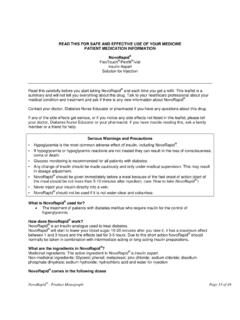
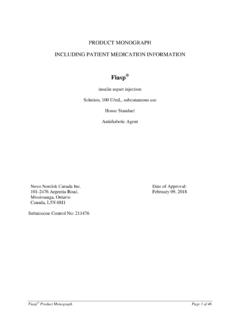

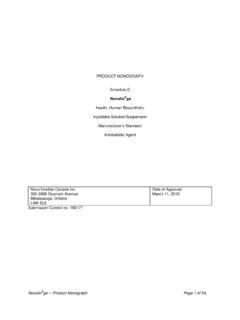

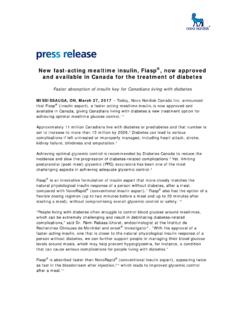
![[Product Monograph Template - Standard] - …](/cache/preview/a/9/a/b/c/6/8/3/thumb-a9abc683523644e52c439669ba6e5b27.jpg)
![[Product Monograph Template - Standard]](/cache/preview/1/3/7/9/6/d/a/a/thumb-13796daa617bc65beb773a3c01593750.jpg)

